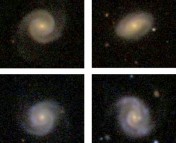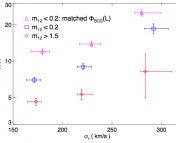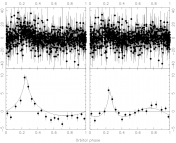Title: Evidence for a Constant Initial Mass Function in Early-Type Galaxies Based On Their X-ray Binary Populations
Authors: Mark B. Peacock, Stephen E. Zepf, Thomas J. Maccarone, Arunav Kundu, Anthony H. Gonzalez, Bret D. Lehmer, Claudia Maraston
First Author’s institutions: Michigan State University
Motivation
Think of the stars in a galaxy as an iceberg. When we observe a galaxy, we see only the brightest stars, or the tip of the iceberg. To infer how much of the iceberg is hidden, we must make a few assumptions. One assumption is the shape of the initial mass function (IMF). The IMF is the initial distribution of masses in a population of stars. In the Milky Way, the measured IMF is similar across a range of environments. Until recently this same shape has been assumed for other galaxies. In the past few years, studies have found evidence that the IMF in elliptical galaxies varies systematically with galaxy mass. The authors of this paper revisit that question by counting the remnants of massive stars.
When massive stars die, they become neutron stars and black holes – collectively called stellar remnants. When a stellar remnant is in a close binary system with a star, it can pull matter from the star. This accretion is energetic enough to produce X-rays that can be detected in other galaxies. If the donor star is low-mass, these systems are called low-mass X-ray binaries (LMXBs). By comparing the number of LMXBs in different galaxies, we can compare the number of massive stars that were formed in these galaxies. If we divide the number of LMXBs by the number of low-mass stars (as traced by the galaxy’s light), we can compare the shape of the IMF in these galaxies. The authors take this strategy to compare the IMF in eight galaxies.
Methods
The authors select a sample of eight galaxies which have deep X-ray observations in the Chandra observatory data archive. The sample is also required to have Hubble Space Telescope (HST) photometry to measure the total galaxy light and exclude X-ray sources in background galaxies and globular clusters.To count the number of LMXBs in the galaxies, the authors first need to throw out other X-ray sources. Active galactic nuclei emit X-rays from the accretion of matter onto a supermassive black hole. If these are lurking in the background behind the target galaxies, they must be excluded from the tally of LMXBs. Another type of X-ray source that the authors exclude is LMXBs in globular clusters hosted by the target galaxies.
Why exclude LMXBs just because they’re in globular clusters? Remember that LMXBs are binary systems. In globular clusters, the stars are packed so tightly that binary systems can be formed by the interaction between two single stars. This enhances the numbers of LMXBs in globular clusters. Counting the LMXBs in globular clusters will lead us to believe that a galaxy with more globular clusters has more stellar remnants, biasing the IMF comparison. The authors exclude LMXBs in background galaxies and globular clusters by matching X-ray sources found in the Chandra data with optical counterparts in the HST data. All X-ray sources which have an optical counterpart are thrown out of the analysis.

Ratio between the number of LMXBs and K-band luminosity (nx) versus velocity dispersion (σ).The black points are galaxy data. The dashed lines are predictions for a constant IMF (red) and an IMF that varies systematically with σ, as predicted by previous studies (blue). The only change in the bottom panel is that it only includes brighter LMXBs, which allows a significant measurement in the 8th galaxy. In both cases, the galaxies are consistent with a constant IMF.
After discarding interlopers, the authors count the number of LMXBs in each galaxy and divide by the total K-band luminosity of that galaxy. The K-band light traces the red giants in these galaxies, which are close to solar mass. The ratio between the number of LMXBs and the K-band luminosity is a measure of the shape of the IMF. The recent studies of the IMF in elliptical galaxies predict that this ratio decreases (there are fewer LMXBs per unit of K-band luminosity) as total galaxy mass increases. What did these authors find?
Results
In Figure 1, the number of LMXBs divided by the total K-band luminosity is plotted against velocity dispersion (σ) for each galaxy. σ in these galaxies is directly related to total galaxy mass. The LMXB counts in 7 of the galaxies show no evidence for a variable IMF. One outlier galaxy has unexpectedly few LMXBs. This outlier cannot be explained by a systematic variation in the IMF, but the cause of the discrepancy is unknown.
Conclusions
The evidence from low-mass X-ray binary counts does not support the claim that the initial mass function varies systematically with galaxy mass. This is especially puzzling because of the studies which do find that more massive galaxies have more low-mass stars relative to high-mass stars. This finding motivates deep X-ray observations for a larger sample of galaxies, to measure the low-mass X-ray binary population in a wider range of galaxy masses. In the meantime, we’ll just have to keep guessing how much of the iceberg is lurking out of view.





Nice article, Jesse! Determining the IMF is so important for understanding galaxy evolution. Do the authors comment on the extent to which mass transfer can affect their analysis? The LMXBs are low-mass now, but they are also losing mass. What is the mass transfer rate, and what were the masses of the low-mass donors initially?